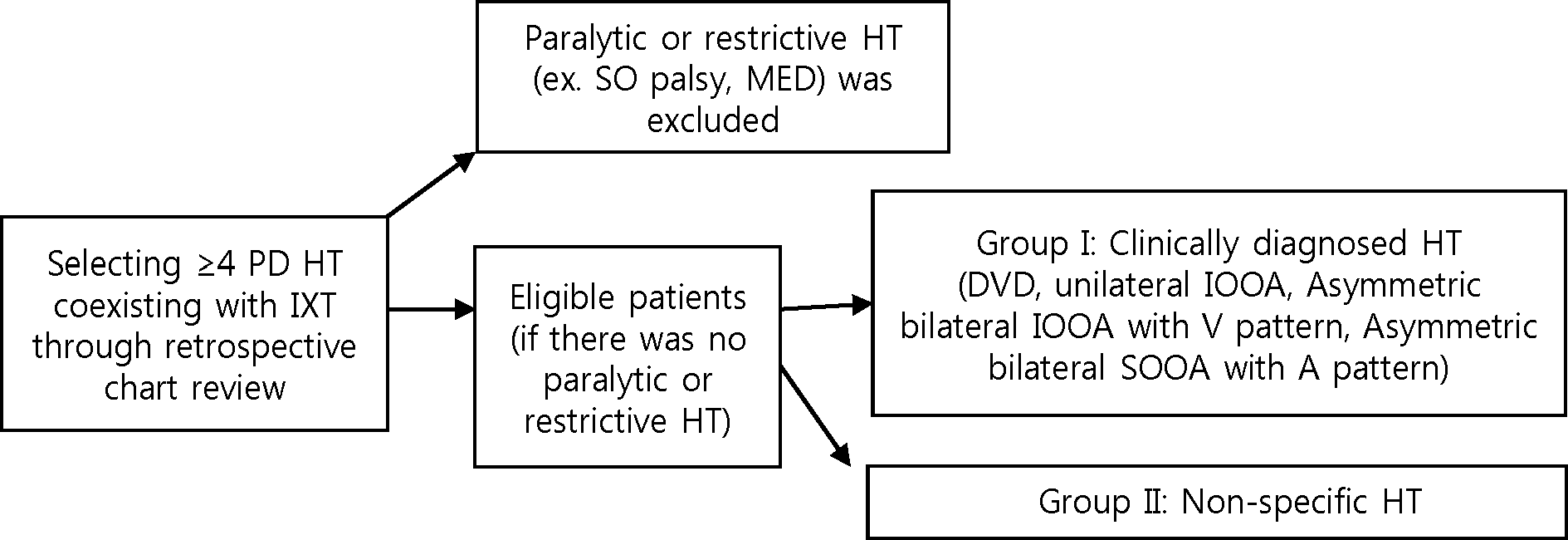Abstract
Purpose
Methods
Results
Conclusions
References
 | Figure 1.Flow diagram summarizing the stepwise categorization of the patients with hypertropia coexisting with intermittent exotropia. PD = prism diopter; HT = hypertropia; IXT = intermittent exotropia; SO = superior oblique; MED = monocular elevation deficiency; DVD = dissociated vertical deviation; IOOA = inferior oblique overaction; SOOA = superior oblique overaction. |
Table 1.
| Demographics | Results |
|---|---|
| N | 148 |
| Sex (M:F) | 70:78 |
| Mean age at surgery (years) | 12.47 ± 9.98 |
| Mean amount of preoperative exodeviation (PD) | 30.15 ± 1.76 |
| Mean amount of postoperative exodeviation (PD) | 7.17 ± 8.14 |
| Mean amount of preoperative hypertropia (PD) | 12.47 ± 9.89 |
| Laterality of the coexisting hypertropia (n) | |
| RHT | 78 |
| LHT | 58 |
| DVD (both) | 12 |
| Same as exotropic eye* | 49 |
| Opposite to exotropic eye* | 38 |
Table 2.
Table 3.
Table 4.
Table 5.
Values are presented as mean ± SD; Pattern 1: increment of HT angle on contralateral gaze, contralateral side gaze PD-ipsilateral side PD >4 PD; Pattern 2: increment of HT angle on ipsilateral gaze, ipsilateral side gaze PD-contralateral side PD >4 PD; Pattern 3: Bielschowsky HTT positive (increment of HT angle on ipsilateral HTT), ipsilateral HTT PD contralateral HTT PD>8 PD; Pattern 4: reversed Bielschowsky HTT positive (increment of HT angle on contralateral HTT), contralateral HTT PD-ipsilateral HTT PD >8 PD. HT = hypertropia; PD = prism diopter; HTT = head tilt test.
Table 6.
Pattern 1: increment of hypertropia (HT) angle on contralateral gaze, contralateral side gaze prism diopter (PD)-ipsilateral side PD >4 PD; Pattern 2: increment of HT angle on ipsilateral gaze, ipsilateral side gaze PD-contralateral side PD >4 PD; Pattern 3: Bielschowsky head tilt test (HTT) positive (increment of HT angle on ipsilateral HTT), ipsilateral HTT PD-contralateral HTT PD >8 PD; Pattern 4: reversed Bielschowsky HTT positive (increment of HT angle on contralateral HTT), contralateral HTT PD-ipsilateral HTT PD >8 PD.




 PDF
PDF ePub
ePub Citation
Citation Print
Print


 XML Download
XML Download